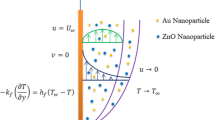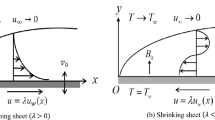Abstract
Hybrid nanofluids are introduced as heat transfer fluids with greater surface stability, diffusion and dispersion capabilities compared to traditional nanofluids. In this work, flow, convective heat transport and volumetric entropy generation in Powell–Eyring hybrid nanofluid are investigated. Hybrid nanofluid occupies the space over the uniform horizontal porous stretching surface with velocity slip at the interface. Effect of viscous dissipation and linear thermal radiation are also included in the simplified model. Mathematical equations for conservation of mass, momentum, energy and entropy are simplified under assumptions of boundary layer flow of Powell–Eyring hybrid nanofluid. Similarity solutions are obtained by transformation of governing partial differential equations to ordinary differential equations, using similarity variables. Keller box finite difference scheme is then adopted to find the approximate solutions of reduced ordinary differential equations. Numerical computations are performed for alumina–copper water (\({\mathrm{Al}}_2{\mathrm{O}}_3\)–\({\mathrm{Cu/H}}_{2}{\mathrm{O}}\)) hybrid nanofluid and conventional copper water (\({\mathrm{Cu}}\)–\({\mathrm{H}}_{2}{\mathrm{O}}\)) nanofluid. Graphs are produced for velocity, temperature and entropy profiles to study the effect of governing parameters. Skin friction factor and the local Nusselt number are also calculated at the boundary. The notable findings indicate that the hybrid Powell–Eyring nanofluid is better thermal conductor when compared with the conventional nanofluid. The rate of heat transfer at the boundary is greatest for smallest value of the shape factor parameter. The increase in Reynolds number and Brinkman number increases the overall entropy of the system.























Similar content being viewed by others
References
Andersson HI, Aarseth JB, Dandapat BS. Heat transfer in MHD viscoelastic fluid flow over a stretching sheet with variable thermal conductivity, non-uniform heat source and radiation. Int J Heat Mass Transf. 2000;43:69–74.
Cortell R. A note on flow and heat transfer of a viscoelastic fluid over a stretching sheet. Int J Non-Linear Mech. 2006;41:78–85.
Rasheed A, Anwar MS. Simulations of variable concentration aspects in a fractional nonlinear viscoelastic fluid flow. Commun Nonlinear Sci Numer Simul. 2018;65:216–30.
Rehman TU, Ali HM, Janjua MM, Sajjad U, Yan WM. A critical review on heat transfer augmentation of phase change materials embedded with porous materials/foams. Int J Heat Mass Transf. 2018;135:649–73.
Ghadikolaei SS, Hosseinzadeh KH, Yassari M, Sadeghi H, Ganji DD. Analytical and numerical solution of non-Newtonian second-grade fluid flow on a stretching sheet. Therm Sci Eng Prog. 2018;5:309–16.
Rahmati AR, Akbari OA, Marzban A, Karimi R, Pourfattah F. Simultaneous investigations the effects of non-Newtonian nanofluid flow in different volume fractions of solid nanoparticles with slip and no-slip boundary conditions. Therm Sci Eng Prog. 2018;5:263–77.
Rehman TU, Ali HM, Saieed A, Pao W, Ali M. Copper foam/PCMs based heat sinks: an experimental study for electronic cooling systems. Int J Heat Mass Transf. 2018;127:383–91.
Rasheed A, Anwar MS. Interplay of chemical reacting species in a fractional viscoelastic fluid flow. J Mol Liq. 2019;273:576–88.
Sajawal M, Rehman TU, Ali HM, Sajjad U, Raza A, Bhatti MS. Experimental thermal performance analysis of finned tube-phase change material based double pass solar air heater. Case Stud Therm Eng. 2019;15:100543–12.
Rehman TU, Ali HM. Thermal performance analysis of metallic foam-based heat sinks embedded with RT-54HC paraffin: an experimental investigation for electronic cooling. J Therm Anal Calorim. 2020;140:979–90.
Rehman TU, Ali HM. Experimental study on the thermal behavior of RT-35HC paraffin within copper and iron–nickel open cell foams: energy storage for thermal management of electronics. Int J Heat Mass Transf. 2020;146:118852.
Choi SUS. Enhancing thermal conductivity of fluids with nanoparticles. In: ASME International Mechanical Engineering Congress and Exposition, vol 66; 1995. p. 99–105.
Qing J, Bhatti MM, Abbas MA, Rashidi MM, Ali MS. Entropy generation on MHD Casson nanofluid flow over a porous stretching/shrinking surface. Entropy. 2016;18:123.
Aziz T, Aziz A, Khalique CM. Exact solutions for stokes flow of a non-Newtonian nanofluid model: a lie similarity approach. Z Naturforschung A. 2016;71:621.
Tausif MD, Das D, Kundu PK. Presence of different shapes of ZrO2 nanoparticles in the melting heat transfer of a Casson flow. Eur Phys J Plus. 2017;132:425.
Bhatti MM, Abbas T, Rashidi MM, Ali MS, Yang Z. Entropy generation on MHD Eyring–Powell nanofluid through a permeable stretching surface. Entropy. 2017;18:224.
Koriko OK, Animasaun IL, Reddy MG, Sandeep N. Scrutinization of thermal stratification, nonlinear thermal radiation and quartic autocatalytic chemical reaction effects on the flow of three-dimensional Eyring–Powell alumina–water nanofluid. Multidiscip Model Mater Struct. 2018;14:261–83.
Aziz A, Jamshed W. Unsteady MHD slip flow of non-Newtonian Power-law nanofluid over a moving surface with temperature dependent thermal conductivity. Discrete Contin Dyn Syst Ser S. 2018;11:617–30.
Qayyum S, Hayat T, Alsaedi A. Thermal radiation and heat generation/absorption aspects in third grade magneto-nanofluid over a slendering stretching sheet with Newtonian conditions. Phys B Phys Condens Matter. 2018;537:139–49.
Justh N, Berke B, Laszlo K. Thermal analysis of the improved Hummers synthesis of graphene oxide. J Therm Anal Calorim. 2018;131:2267.
Selimefendigil F, Chamkha AJ. Magnetohydrodynamics mixed convection in a power law nanofluid-filled triangular cavity with an opening using Tiwari and Das’ nanofluid model. J Therm Anal Calorim. 2019;135:419.
Aziz A, Shams M. Entropy generation in MHD Maxwell nanofluid flow with variable thermal conductivity, thermal radiation, slip conditions and heat source. AIP Adv. 2020;10:015038.
Akram N, Sadri R, Kazi SN. A comprehensive review on nanofluid operated solar flat plate collectors. J Therm Anal Calorim. 2020;139:1309.
Suresh S, Venkitaraj K, Selvakumar P, Chandrasekar M. Experimental investigation of mixed convection with synthesis of Al2O3–water hybrid nanofluids using two step method and its thermo physical properties. Colloids Surf. 2011;08:41–8.
Devi SSU, Devi SPA. Numerical investigation on three dimensional hybrid Cu–Al2O3/water nanofluid flow over a stretching sheet with effecting Lorentz force subject to Newtonian heatings. Can J Phys. 2016;94:490–6.
Devi SPA, Devi SSU. Numerical investigation of hydromagnetic hybrid Cu–Al2O3 water nanofluid flow over a permeable stretching sheet with suction. J Nonlinear Sci Appl. 2016;17:249–57.
Afrand M, Toghraie D, Ruhani B. Effects of temperature and nanoparticles concentration on rheological behavior of Fe3O4–Ag/EG hybrid nanofluid: an experimental study. Exp Therm Fluid Sci. 2016;77:38–44.
Hayat T, Nadeem S. Heat transfer enhancement with Ag–CuO/water hybrid nanofluid. Results Phys. 2017;7:2317–24.
Ghadikolaei SS, Yassari M, Hosseinzadeh KH, Ganji DD. Investigation on thermophysical properties of TiO2–Cu/H2O hybrid nanofluid transport dependent on shape factor in MHD stagnation point flow. Powder Technol. 2017;322:428–38.
Hussain S, Ahmed SE, Akbar T. Investigation on thermophysical properties of TiO2–Cu/H2O hybrid nanofluid transport dependent on shape factor in MHD stagnation point flow. Int J Heat Mass Transf. 2017;114:1054–66.
Mehrali M, Sadeghinezhad E, Akhiani AR, Latibari ST, Metselaar HSC, Kherbeet AS, Mehrali M. Heat transfer and entropy generation analysis of hybrid graphene/Fe3O4 ferro-nanofluid flow under the influence of a magnetic field. Powder Technol. 2017;308:149–57.
Acharya N, Bag R, Kundu PK. Influence of Hall current on radiative nanofluid flow over a spinning disk: a hybrid approach. Phys E Low Dimens Syst Nanostruct. 2019;111:103–12.
Anuar NS, Bachok N, Arifin NM, Rosali H, Pop I. Stagnation point flow and heat transfer over an exponentially stretching/shrinking sheet in hybrid nanofluid with slip velocity effect: stability analysis. J Phys Conf Ser. 2019;1366:012002.
Waini I, Ishak A, Pop I. Hybrid nanofluid flow and heat transfer past a permeable stretching/shrinking surface with a convective boundary condition. J Phys Conf Ser. 2019;1366:012022.
Waini I, Ishak A, Pop I. Unsteady flow and heat transfer past a stretching/shrinking sheet in a hybrid nanofluid. Int J Heat Mass Transf. 2019;136:288–97.
Waini I, Ishak A, Pop I. Hybrid nanofluid flow and heat transfer over a nonlinear permeable stretching/shrinking surface. Int J Numer Methods Heat Fluid Flow. 2019;29:3110–27.
Maskeen MM, Zeeshan A, Mehmood O, Hassan M. Heat transfer enhancement in hydromagnetic alumina–copper/water hybrid nanofluid flow over a stretching cylinder. J Therm Anal Calorim. 2019;138:1127–36.
Huminic G, Huminic A. The heat transfer performances and entropy generation analysis of hybrid nanofluids in a flattened tube. Int J Heat Mass Transf. 2018;119:813–27.
Bahiraei M, Mazaheri N. Application of a novel hybrid nanofluid containing grapheme–platinum nanoparticles in a chaotic twisted geometry for utilization in miniature devices: thermal and energy efficiency considerations. Int J Mech Sci. 2018;138:337–49.
Jamshed W, Aziz A. Cattaneo–Christov based study of TiO2–Cu/H2O Casson hybrid nanofluid flow over a stretching surface with entropy generation. Appl Nanosci. 2018;8:01–14.
Aziz A, Jamshed W, Ali Y, Shams M. Heat transfer and entropy analysis of Maxwell hybrid nanofluid including effects of inclined magnetic field, Joule heating and thermal radiation. Discrete Contin Dyn Syst Ser S. 2020;13(10):2667–90.
Tiwari RJ, Das MK. Heat transfer augmentation in a two-sided lid-driven differentially heated square cavity utilizing nanofluids. Int J Heat Mass Transf. 2007;50:2002–18.
Powell R, Eyring H. Mechanism for relaxation theory of viscosity. Nature. 1944;154:427–8.
Hayat T, Imtiaz M, Alsaedi A. Effects of homogeneous-heterogeneous reactions in flow of Powell–Eyring fluid. J Cent South Univ. 2015;22:3211–6.
Hayat T, Qasim M, Mesloub S. MHD flow and heat transfer over permeable stretching sheet with slip conditions. Int J Numer Methods Fluids. 2011;66:963–75.
Jamshed W, Aziz A. A comparative entropy based analysis of Cu and Fe3O4/methanol Powell–Eyring nanofluid in solar thermal collectors subjected to thermal radiation, variable thermal conductivity and impact of different nanoparticles shape. Results Phys. 2018;9:195–205.
Brewster MQ. Thermal radiative transfer and properties. New York: Wiley; 1992.
Keller HB. A new difference scheme for parabolic problems. In: Hubbard B, editor. Numerical solutions of partial differential equations, vol. 2. New York: Academic Press; 1971. p. 327–50.
Vajravelu K, Prasad K. Keller-box method and its application. Berlin: De Gruyter; 2014.
Mutuku WN. Ethylene glycol (EG)-based nanofluids as a coolant for automotive radiator. Asia Pac J Comput Eng. 2016;3:1.
Reddy JVR, Sugunamma V, Sandeep N. Impact of nonlinear radiation on 3D magnetohydrodynamic flow of methanol and kerosene based ferrofluids with temperature dependent viscosity. J Mol Liq. 2017;236:93–100.
Mahmood A, Jamshed W, Aziz A. Entropy and heat transfer analysis using Cattaneo–Christov heat flux model for a boundary layer flow of Casson nanofluid. Results Phys. 2018;10:640–9.
Alsaedi A, Hayat T, Qayyum S, Yaqoob R. Eyring–Powell nanofluid flow with nonlinear mixed convection: entropy generation minimization. Comput Methods Prog Biomed. 2020;186:105183.
Ishak A, Nazar R, Pop I. Mixed convection on the stagnation point flow towards a vertical, continuously stretching sheet. ASME J Heat Transf. 2007;129:1087–90.
Ishak A, Nazar R, Pop I. Boundary layer flow and heat transfer over an unsteady stretching vertical surface. Meccanica. 2009;44:369–75.
Abolbashari MH, Freidoonimehr N, Nazari F, Rashidi MM. Entropy analysis for an unsteady MHD flow past a stretching permeable surface in nano-fluid. Powder Technol. 2014;267:256–67.
Das S, Chakraborty S, Jana RN, Makinde OD. Entropy analysis of unsteady magneto-nanofluid flow past accelerating stretching sheet with convective boundary condition. Appl Math Mech. 2015;36(2):1593–610.
Acknowledgements
The authors would like to thank the reviewers for their helpful comments and feedback with a view to improve the manuscript. TA and HMSB also would like to acknowledge the adequate support they have received from King Fahd University of Petroleum and Minerals
Author information
Authors and Affiliations
Corresponding author
Additional information
Publisher's Note
Springer Nature remains neutral with regard to jurisdictional claims in published maps and institutional affiliations.
Rights and permissions
About this article
Cite this article
Aziz, A., Jamshed, W., Aziz, T. et al. Entropy analysis of Powell–Eyring hybrid nanofluid including effect of linear thermal radiation and viscous dissipation. J Therm Anal Calorim 143, 1331–1343 (2021). https://doi.org/10.1007/s10973-020-10210-2
Received:
Accepted:
Published:
Issue Date:
DOI: https://doi.org/10.1007/s10973-020-10210-2




